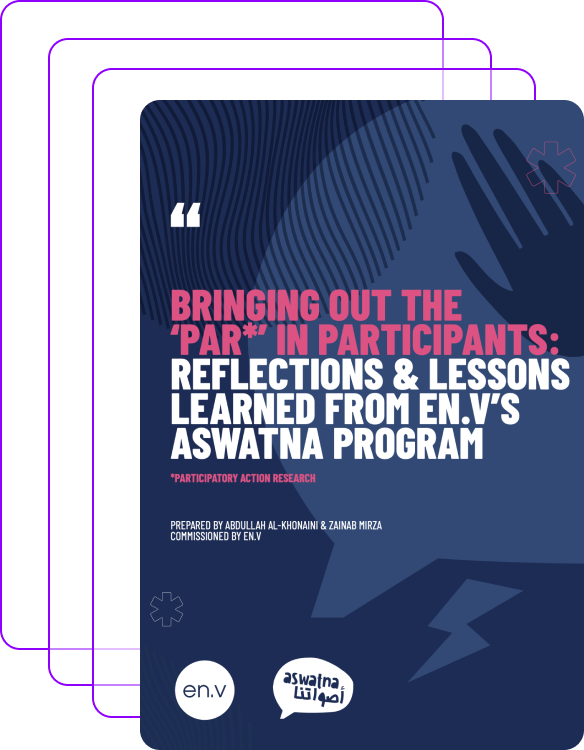
Our Participatory Action Research has enabled us to collect data about us, by us, for you to help transform our education!
How You Can Engage with the Data
We invite government stakeholders, school principals, teachers, and students to explore the data provided below. Feel free to question it and build on it within your own contexts. This data offers a deeper understanding of our school environments and encourages us to remain curious and open to further collaborative efforts and participatory research in schools.
For educators, we encourage you to incorporate these topics into classroom discussions or even organize participatory activities to delve into these issues with your students. Aswatna was born from the idea of being student-led, by students, for students. Let's continue to celebrate our students' contributions in improving our school spaces.

Our data
Interested in learning more about how we could build youth agency, develop more responsive and participatory programs, or create more inclusive spaces? Check out our recommendations and toolkits for youth leaders, educators, administrators and anyone else willing to do the work!
68
Students who completed the training
22
Schools students represented
62
Number of Ideathon participants
88
Issues identified by students during PAR module
1,203
Number of people interviewed / surveyed through PAR projects
6
Issues being addressed in our pilot projects (school governance, inclusion, curriculum diversity, mental health, safe spaces, discrimination)
How to view and use our data!
As you explore our teams’ research and the insights derived from the data, remember that Aswatna is rooted in the principles of participatory action research (PAR). Our aim is to promote reflection and continuous improvement through thoughtful cycles of inquiry among young participants.
The data presented in our projects is a collaborative effort, co-created by both research teams and research participants during their PAR journey. We offer these general guidelines to assist you in interpreting the data:
• Participatory action research (PAR) proves highly valuable in youth programs, offering youth a safe space to understand their surroundings better. In educational contexts, it aids in comprehending social situations and driving social change through collective efforts.
• Aswatna is specifically designed to conduct PAR projects involving marginalized or disempowered individuals. It tackles issues of inequality, empowerment, participation, and fosters collaborative action.
• The data in this report is derived from the perspectives of both participants and researchers, collaboratively generating knowledge by delving into the root causes of issues. It's important to note that this analysis isn't definitive; rather, it serves as an indicator of these issues and highlights the lived experiences of participants and researchers during the data collection phase.
• External researchers conducted a thematic analysis of the data collected by our PAR teams. They also engaged in interviews with the PAR team to validate findings and reflect on the data collection process.
Participatory Action Research projects and data
Here is a gallery of our participatory action research projects and their corresponding data.
Safe spaces
The traditional school model often overlooks the importance of providing students with emotional, psychological, and cultural resources. Safe spaces in schools address these gaps, ensuring students are equipped to flourish in all areas of life.
Lack of diversity in school curriculums
Diverse school curriculums enrich learning, foster understanding, and reflect varied experiences, ensuring students are prepared for a globally interconnected world.
See what we found
Low grade students
Society often unfairly discriminates against low-graded students, limiting their opportunities to succeed and taking away their voice.
See what we found
Inclusivity
Inclusivity in our curriculum could foster understanding, empathy, representation, respect, and prepare students to engage with a diverse global community. We have a lot to learn from each other…
School governance
Including students in school governance ensures relevant, impactful decisions that resonate with the entire academic community.
See what we found
School facilities
Well-designed school facilities and environments that cater to diverse student needs promote inclusive learning!
See what we found
Mental health awareness
Prioritizing mental health in schools enhances learning, fosters resilience, supports well-being, and creates a nurturing educational environment for all students.
See what we found
Identity-based discrimination towards youth in schools
Identity-based discrimination towards youth in schools undermines self-worth, hampers learning, perpetuates inequalities, and impedes the cultivation of inclusive, diverse communities.
See what we found
Discrimination based on race and religion
Racial and religious discrimination in schools can have a profound and negative impact on the well-being, self-esteem, and sense of belonging of youth, potentially hindering their academic success and emotional development.
See what we found
Body shaming
Body shaming damages self-esteem, promotes unhealthy behaviours, perpetuates unrealistic standards, and undermines the celebration of diverse body types and self-worth.
See what we found
Mental health and safety
Ensuring children's safety within schools is paramount. Schools bear the responsibility of nurturing students' psychological well-being to cultivate emotionally resilient and socially adept adults.
See what we found
The Ideathon generating ideas for the future
See how the research projects above influenced how we put together our Ideathon and how teams created concepts, ideas and interventions to help solve some of the pressing issues that we face.
Tools and resources
Here you will find more details about how and why Aswatna came into existence, an analysis of the demographics of each cohort and the issues they identified, as well as lessons learned from our major stakeholders—the en.v team, trainers, and of course the participants. We close with recommendations for schools, students, organizers, and other stakeholders who may want to adopt Aswatna into their own spaces.















